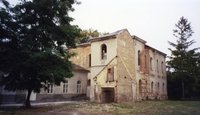Baden bei Wien
|
|
| Statistics | |
|---|---|
| State: | Lower Austria |
| District: | Baden |
| Area: | 26.89 km² |
| Population: | 24,502 (12/31/2002) |
| Population density: | 911/km² |
| Geographic location: | Template:Coor dms |
| Elevation: | 230 m |
| Postal code: | 2500 |
| Municipal code: | 30604 |
| Car designation: | BN
|
| Arrangement of the city: | 7 districts katastralgemeinden |
| Address of the city administration: | 1 Hauptplatz Baden 2500 |
| Website: | www.baden-bei-wien.at |
Baden bei Wien is a city in Lower Austria, 26 kilometres South of Vienna. Population (2002) 31,000.
It is situated at the mouth of the romantic Helenental, on the banks of the Schwechat, and used to be the principal summer resort of the wealthy inhabitants of Vienna, the neighbouring capital. It possesses a Kurhaus, fifteen bathing-establishments, a parish church in late Gothic style, and a town-hall, which contains archives. The warm baths, which gave name to the town, are thirteen in number, with a temperature of from 22° C (72° F) to 36° C (97° F), and contain, as chief ingredient, sulphate of lime. They rise for the most part at the foot of the Calvarienberg (1070 ft.), which is composed of dolomitic limestone, and are mostly used for bathing purposes. Baden is surrounded by about 120 vineyards and has about 70 wine pubs ("Heurige").
Baden may be reached by the Südautobahn (A2) and is linked with the Südbahn rail with a train station and the Badener Bahn.
| Contents [hide] |
Neighborhoods
- Baden
- Braiten
- Gamingerhof
- Leesdorf
- Mitterberg
- Rauhenstein
- Weikersdorf Image:Umgebung von Wien (Einseitige Farbkarte).jpg
Points of interest
The celebrity of Baden dates back to the days of the Romans, who knew it by the name of Thersnae Pannonicae, and remains of their occupation still exist. It received its charter as a town in 1480, and although sacked at various times by Hungarians and Turks, it soon flourished again.
Several members of the Austrian imperial family had made Baden their summer residence and have built here beautiful villas. Baden possesses several parks and is surrounded by lovely and interesting spots, of which the most frequented is the picturesque valley of the Helenental, which is traversed by the Schwechat. Not far from Baden, the valley is crossed by the magnificent aqueduct of the Vienna waterworks. At the entrance to the valley, on the right bank of the river, lie the ruins of the 12th century castle of Rauheneck, and at its foot stands the Château Weilburg, built in 1820-1825 by Archduke Charles, the victor of Aspern. On the left bank, just opposite, stands the ruined castle of Rauhenstein, dating also from the 12th century. About 4 m. up the valley is Mayerling, a hunting-lodge, where Crown Prince Rudolph of Austria was found dead in 1889. Farther up is Alland, whence a road leads to the old and well-preserved abbey of Heiligenkreuz. It possesses a church, in Romanesque style, dating from the 11th century, with fine cloisters and the tombs of several members of the Babenberg family. The highest point in the neighbourhood of Baden is the peak of the Hoher Lindkogel (2825 ft.), popularly called Eisernes Tor (iron gate), which is ascended in about three hours.
The famous composer Ludwig van Beethoven stayed a number of times in Baden, and many of his residences can still be seen today. Street addresses include Antonsgasse 4, Breitnerstrasse 26, Frauengasse 10, Johannesbadgasse 12, Kaiser Franz Ring 9, Rathausgasse 10 (a museum open to the public), and Weilburgstrasse 13.
Castles

- Burg Rauheneck in Rauheneck
- Ruined castle of Rauhenstein
- Scharfeneck Castle
Umgebung_von_Wien_(Einseitige_Farbkarte).jpg
External link
- Official homepage (in English) (http://www.baden-bei-wien.at/english.htm)de:Baden bei Wien

